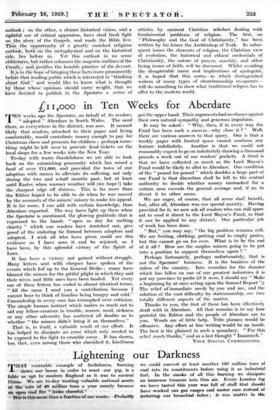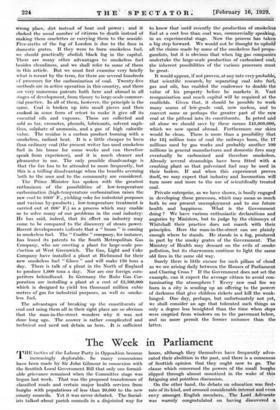Lightening our Darkness FIIIIAT venerable example -of foolishness, burning •
-411-i-• -down our house in order to roast our pig, is a fable as apt to modern -England- as it' was to ancient Chinai -We arc to-day wasting valuable national- assets a-the''rate of -40 million -tons a year merely-because • ail men-Coal Rie " looks cheerful:" • ■ •-• . . `1+10i is this more than-a fraction Of our, waste,--ProbaMy we could convert at least another 130 million tons at coal into- its constituents before using it as industrial fuel. In the-smoke . of all this burning we dissipate an immense treasure into thin air. Every London fog we:have- tasted this year was full of stuff that should have 'worked our gas ranges and motor ears instead of irritating our bronchial tubes ; it -was matter in the • wrong' place, _dirt -instead of heat 'and- power ; -and- 4t Choked the usual number of "citizens to death 'instead of making them omelettes or carrying them to the seaside: Five-sixths Of the fog of London is due to the fires in domestic grates. If. they were to burn smokeless fuel, we shoUld practically abolish black fog in the capital. There are many other advantages to smokeless fuel besides cleanliness; and we shall refer to some of them in this article. But we must first examine- very briefly what is meant by the term, for 'there are several hundreds of prOcesses for the carbonization' of coal. Twenty-five methods are in active operation in this "country, - and there are very numerous patents both here and abroad in all stages of development, from theory to large:scale commer- cial practice. In all of them, however, -the principle is the same. Coal is' broken up .inte• small pieces and 'then cociked..in some form of retort to make it give off its essential oils.. and vapours. These are collected and sold as tar, creosotes, phenols, lubricants, solvent naph- thus, sulphate of ammonia, and a gas of high calorific value. The residue is a carbon product burning with . a smokeless, radiant heat. It is a .little cheaper to burn than ordinary coal (the present .writer has used smokeless fuel in his house for some weeks and can therefore speak from experience), and it is much cleaner and pleasanter in use. The only possible disadvantage is that the fire has to be attended to more frequently,_ but this is a trifling disadvantage when the benefits accruing both to the user and, to the community are considered.
The 'Prime.. Minister has spoken with the- greatest enthusiasm- of the possibilities of - low-temperature carbonization (high-temperature carbonization raises the raw-coal to 1060° F.; yielding coke for industrial purposes and various by-products ; low-temperature -treatment-is carried out at 600° F,) as a process which • may enable us to solve many of our problems in the coal industry, He has said, indeed, that its effect on industry may come to be compared to the discovery of steam power. Recent 'developments. indicate that a " boom " is coming in smokeless fuel. The " Coalite " company, for instance, has -leased its patents to the South Metropolitan Gas Company, who are erecting a plant for large-scale pro- duction at West Greenwich. The Gas, Light and Coke Company- have installed a plant at Richmond for their new smokeless fuel " Gloco " and will make 150 tons a day. There is talk of a plant in the North of England to produce 1,000 tons a day. Nor are our foreign com- petitors- behindhand. In Germany the Ruhr Gas Cor- poration are installing a plant at a cost of £2,500,000 which is designed to yield ten thousand million cubic metres of gas for industrial purposes, as well as smoke- less fuel.
The advantages of breaking up the constituents of coal and using them all in their right place are so obvious that the man-in-the-street wonders why it' was not done long ago. The answer is rather complicated and technical and need not detain us here. It is sufficient for know that until irecently the production of smOkeless fuel at aeoit lesS than coal was, commercially speaking, in an eXPefiniental Stage. Now the process has taken a.big step forward. We would not be thought to uphold all the claims made by some of the smokeless fuel propa- gandists, but it is obvions- that when big gas companies undertake :the" large-scale production of carboniied coal; the inherent possibilities Of the various processes must be great. It would appear, if not prOven, at any rate very probable, that scientific research; by separating coal into fuel, gas and oils, has enabled the coalowner to double the value Of hiS property before he markets- It Vast reorganization and much capital will be required at the coalfields. ' Given that, it should- be possible to work many seams of loW-grade cad, now Useless, and to convert some or perhaps the greater part of the raw coal at the pithead into its constituents. In petrol and oil alone we should save by _ these means 145,000,000, which we now spend abroad. Furthermore our skies would be clean. There is more than a possibility that the 134 million tons of coal the railways burn, the 17 millions used by gas works and probably another 100 millions in general manufactures and domestic fires may eventually be carbonized and therefore smokeless. Already several steamships have been fitted with a . crushing. plant so that pulverized fuel may be used in their boilera. If and when this experiment proves -itself, we may expect that industry and locomotion will turn more and more to the use of scientifically treated coal. ' • - Private enterprise, as we have shown, is busily engaged in- developing these processes, which may mean so much -both to our present unemployment and to our futUre health and happiness. - What is the Government doing ?- We have various enthusiastic declarations and auguries by Ministers, but to judge by the chimneys of Whitehall their practice does not march with their principles. Here the man-in-the-street can see plainly enough where he stands. He -stands in a fog, produced in part by the smoky grates of the Government. The Ministry of -Health may descant on -the evils of smoke pollution, but its charwomen continue to light the same old fires in the same old way. - Surely there is little excuse for such pillars of cloud as we see arising daily between the Houses of Parliament and Charing Cross ? If the Government does not set the example, can it expect the average citizen to avoid con- taminating the atmosphere ? Every raw coal fire we burn in a city is sending up an offering to the powers of darkness- that give children rickets and kill the weak- lunged. One day, perhaps, but unfortunately not yet, we shall consider an age that tolerated such things as only a degree less benighted than the time when slops were emptied from windows on to the payement below, and no more -permit the former nuisance than the latter:











































 Previous page
Previous page